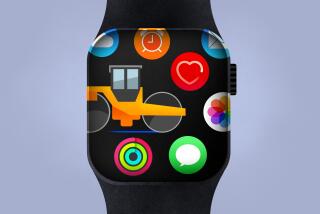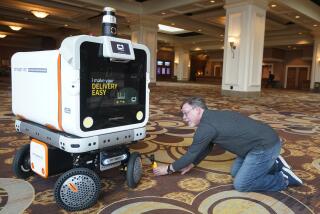PC Brands Boost Consumer Electronics’ Power
- Share via
Five years ago, a device in your home with a powerful microchip, a capacious hard-disk drive and sophisticated software almost certainly would have been just one thing: a computer.
Today, it could just as easily be a portable stereo or a video recorder. It could even be a TV.
The once-yawning gap between computers and consumer electronics is closing as the innards of home entertainment gear incorporate some of the key features of PCs.
These days, TVs are powered by microchips, video recorders store sitcoms on hard drives, and stereos in the living room extract music from the computer in the den.
Driving the trend is the fact that the things that consumer electronics were built to handle -- music, movies, TV, radio, phone calls -- have all been converted from analog to digital.
In other words, said analyst Van Baker at GartnerG2, “they’ve all been translated into the language of information technology.”
The change has opened the consumer electronics business to an invasion of powerhouse brands from the IT industry as well as by tech-savvy start-ups -- all vying to sell smarter audiovisual gear, supply a fat pipeline for programming and deliver a new generation of entertainment on demand.
What’s emerging is a generation of powerful devices that talk to one another and, ultimately, may allow people to get their movies, music, pictures and games wherever and whenever they want.
Illustrating the transformation, the five keynote speakers at next month’s International Consumer Electronics Show in Las Vegas are from companies that make chips, software, computers and cellphones -- not picture tubes or CD players.
The lineup: Microsoft Corp. Chairman Bill Gates, Intel Corp. Chief Executive Craig R. Barrett, Hewlett-Packard Co. Chief Executive Carly Fiorina, Motorola Inc. Chief Executive Ed Zander and Texas Instruments Inc. Chief Executive Rich Templeton.
Nobody is predicting the imminent dethroning of the king brands in consumer electronics, such as Sony Corp., Matsushita Electric Industrial Co.’s Panasonic and Royal Philips Electronics. Those manufacturers have a far better grip on what people want out of their home entertainment gear than their computer industry counterparts.
But analysts and industry executives say the new era in home entertainment demands a different set of skills, playing to some of the computer industry’s strengths.
Chief among them is the ability to network devices and connect them to the Internet, said Rob Crooke, Intel’s vice president of desktop products.
“Ten years ago, devices didn’t communicate with each other, much less with the outside world,” Crooke said. “Today, consumers want to access their entertainment anytime, anywhere. To do that, devices need to be able to communicate with each other and share content. That means building common software and standards so that both ends can talk the same language.”
Paul Liao, president of Panasonic Technologies, which is Panasonic’s research and development unit, said that although people had been talking for years about the convergence of computers and television sets, “for many years they focused on the wrong issue.” There was too much talk about turbocharged TV sets that could surf the Web and display spreadsheets and not enough about devices that could take advantage of the common ground emerging between TVs and PCs.
The focus has changed. At European consumer electronics maker Thomson, for example, the new emphasis is on boxes that can pull music and pictures off a PC or tune in video from the Internet. And in Japan, electronics stores offer video recorders that can transmit programs through a home data network to any room in the house.
“What has been recognized in Europe and Asia,” said analyst Richard Doherty of Envisioneering Group, a technology research firm in Seaford, N.Y., “is a networked world that is never going to be the same again.”
Perhaps the most important of the new skills demanded in the digital era is an expertise in software -- in particular, the software needed to process digitized sounds and images, ship them around the home and interact with the Internet.
“More and more, consumer electronics devices require not just experience in high-quality manufacturing and great industrial design,” said Greg Woock, chief executive of Virgin Electronics, an arm of Richard Branson’s Virgin Group. “They require some really significant software skills because these devices are connecting to PCs and those PCs are connected to sophisticated networks.”
For example, he said, the software on a CD player has to help users navigate through about 15 songs. The software on Apple Computer Inc.’s iPod digital music player has to manage 15,000 songs, “and that requires some real sophisticated knowledge of user interfaces.”
Consumer electronics companies have software engineers too. But they don’t play at the same level, some IT industry veterans contend.
Anthony Wood, chief executive of Palo Alto-based Roku and one of the creators of the Replay digital video recorder, recalled working with Panasonic’s software engineers after the Japanese company licensed Replay’s technology for its own recorders. “The techniques they use are 10 years old, in terms of creating complicated software,” he said.
Said Woock, “The user-interface legacy that the giant consumer electronics guys have left is the blinking ‘12:00’ on your VCR that you don’t know how to turn off.... The legacy that Apple has is ease of use.”
Liao of Panasonic agreed that software was “absolutely one of the keys to success” in the era of the digital home. “If you look at any of the consumer companies, including our own, the number of software engineers has just exploded,” he said.
RealNetworks Inc. Chief Executive Rob Glaser noted that Sony tried to duplicate what Apple has done with the iPod, developing its own software for a hard-drive-based music player. The result, in Glaser’s view: “Sony’s is terrible; Apple’s is very good.”
Some consumer electronics manufacturers are enlisting the help of software companies, rather than trying to do it all themselves, Glaser said. “I think you’re now seeing that they understand that they can’t make world-class products alone.”
If the iPod is a harbinger of things to come in the digital era, the consumer electronics industry increasingly will be shaped by companies with a foot in the world of computers.
Market research firm NPD reported in October that Apple controlled 92% of the market for hard-drive-powered portable music players, with runner-up Creative Technologies Ltd. -- another company with IT industry roots -- holding 3.7%.
“Ninety-two-percent market share, that’s not normal,” Woock said. “That’s because they got all these things largely right, and they’re the only ones that have.”
Among the things that Apple got right, Woock said, is making the iPod easy to use. That’s been one of Apple’s strengths over the years, but it’s not a trait commonly associated with IT companies.
Instead, those companies tend to load up their products with features and power. The result is the kind of complexity that only a geek can love.
Just as software can do great things, Liao said, it can also be buggy and prone to crashing. “So the skill is not just being able to do the software, but doing the software in a way that you reproduce the simplicity and the [reliable] character of hardware,” he said.
The companies that win the battle for the next generation of consumer electronics will be the ones with brands that the average buyer trusts and that stress simplicity instead of power, said GartnerG2’s Baker.
As an example, Baker compared a digital video recorder from a company such as TiVo Inc. with a “living room computer” running Microsoft’s Media Center software. The recorder is “simple and it is easy to use and it is focused” on a limited purpose, Baker said, but the Microsoft software “is just not ready for the average consumer.”
“Get serious, guys,” he said.
Analyst Roger Kay of IDC, a technology research firm in Framingham, Mass., said Microsoft sold about 1 million of its Media Center operating systems in three years. That’s not a bad pace compared with TiVo, which had 2.3 million customers after 5 1/2 years of operations.
But Kay said Microsoft and other IT companies may not fit well into the consumer market. They’re used to selling to businesses, he noted, and businesses tend to tolerate less-than-ideal products that improve over time.
“That’s totally different from consumers, who react very badly if you give them a bad experience to begin with,” Kay said. “The consumer electronics guys get that, and the computer guys are just learning that.”
The invasion of IT companies also changes the industry landscape in another fundamental way, analysts say. Instead of an industry dominated by large, vertically integrated companies that make their own components, there will be room for smaller players that specialize in designing, assembling or supplying pieces for a finished product. That’s because the many industrywide standards for digital products provide a road map into the market, potentially lowering the barriers to entry.
“The nature of the IT industry is that it’s a horizontal one where many people get to play,” Intel’s Crooke said.
Paul Semenza, an analyst at ISupply, a market research firm in El Segundo, gave as an example the flat-screen TV business, in which a number of vendors are selling microchips and other key parts. Other companies are buying the rights to well-known brand names, such as Polaroid and Westinghouse, and slapping them onto products designed and built by low-cost manufacturers in Asia.
“Now, how this all plays out is a big question mark,” Semenza said. “I don’t think the world can support 100 TV companies, each of which has a slightly different twist on making a 37-inch LCD TV.”
So far, at least, the traditional consumer electronics companies are more than holding their own in the battle over flat-screen TVs. Although Gateway Inc., Dell Inc. and Hewlett-Packard have all entered the fray, analysts say their main effect has been to drive down prices, not to capture large shares of the market.
Bob Scaglione, senior vice president of marketing at Sharp Electronics Corp.’s consumer electronics group, said making a TV set with a good picture wasn’t as easy as throwing together a bunch of parts. “There’s a lot of secret sauce” involved in handling moving images and delivering crisp, vibrantly colored video, he said.
Sharp is the leading brand in LCD TVs, controlling more than a third of the market, Scaglione said. That success, he said, stems from the company controlling every element of the production, from design to manufacture to assembly.
That type of vertical integration was common in the days of picture tubes. Today, however, consumer electronics companies often rely on outside sources for the technologies that are taking the place of cathode ray tubes, including plasma panels, LCDs and digital light processing chips.
Still, he said, one thing the IT industry does well is outsource. “That’s their business, pulling together a variety of different parts from different” manufacturers, he said.
Liao of Panasonic said neither approach was necessarily the correct one. “It’s all about who can execute better and who can really deliver on that strategy.” The shift to digital has dropped the barriers to entry in the consumer electronics market, he said, but “the more interesting thing is not, ‘Can you enter?,’ but, ‘Can you prosper? Can you succeed?’
“The hurdles to success are just as high as ever.”







